Rebels and The Raj Class 12 History
| Table of contents |

|
| Introduction |

|
| Pattern of the Uprising |

|
| Two Rebels of 1857 |

|
| Awadh in Revolt |

|
| What the Rebels Wanted |

|
| Repression |

|
| Images of the Revolt |

|
Introduction
- In May 1857, sepoys in Meerut mutinied, starting in the native infantry and quickly spreading to the cavalry and the city.
- The local people joined the sepoys in their rebellion.
- The sepoys captured the arms and ammunition and attacked white people, burning their homes and property.
- Government buildings were destroyed and plundered, and the telegraph line to Delhi was cut.
- A group of sepoys rode towards Delhi and arrived at the Red Fort.
- The Mughal emperor, Bahadur Shah, heard about the rebellion and was told about the mistreatment of Hindus and Muslims by the English.
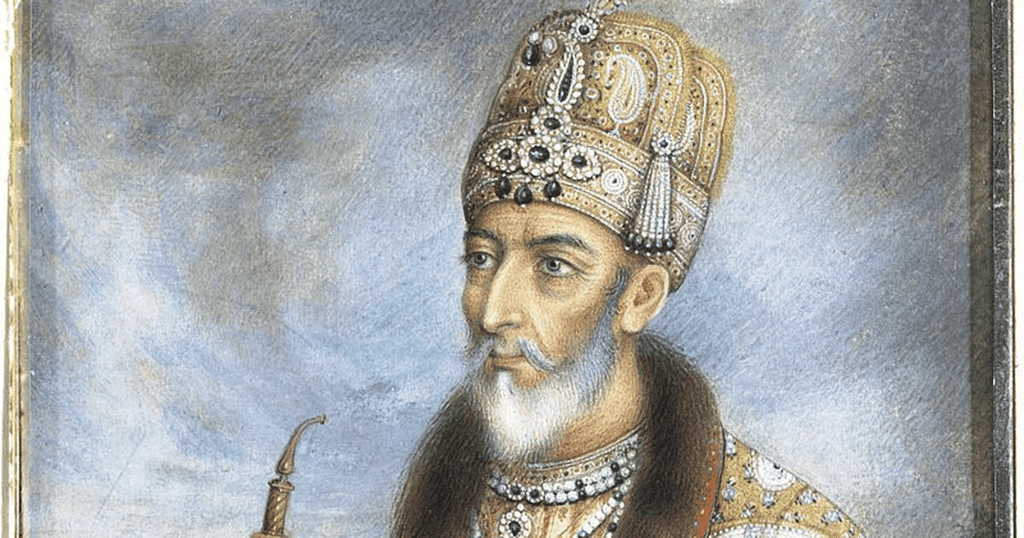 Bahadur Shah
Bahadur Shah
- More sepoys and the people of Delhi joined the rebellion, killing Europeans and looting the wealthy.
- Delhi was now out of British control, and the sepoys demanded the emperor's blessings.
- The revolt gained legitimacy as it could now be carried out in the name of the Mughal emperor.
- North India was calm from 12 to 13 May. News of Delhi's capture by rebels and Bahadur Shah's support quickly spread.
- Mutinies erupted in various cantonments in the Gangetic valley and some areas west of Delhi.
Pattern of the Uprising
The mutinies occurred in a sequential order as news spread from one town to the next. Each cantonment followed a similar pattern of events.
How the Mutinies Began
- The sepoys initiated their action by using signals such as firing the evening gun or sounding the bugle.
- They first targeted the bell of arms and plundered the treasury.
- Government buildings, including the jail, treasury, telegraph office, record room, and bungalows, were attacked and set on fire, destroying all records.
- All individuals associated with the white man were considered targets.
- Proclamations in Hindi, Urdu, and Persian were displayed in cities, urging both Hindus and Muslims to unite and exterminate the British.
- As ordinary people joined the revolt, the targets of attack expanded to include money-lenders and the rich, who were seen as oppressors and allies of the British.
- Peasants looted and destroyed the houses of these targets.
- The mutiny among the sepoy ranks rapidly transformed into a full-fledged rebellion.
- There was a widespread defiance of authority and hierarchy.
- In May and June, the British had no effective response to the rebels' actions.
- Individual British citizens attempted to save their lives and the lives of their families.
- British rule was described as collapsing like a house made of cards.
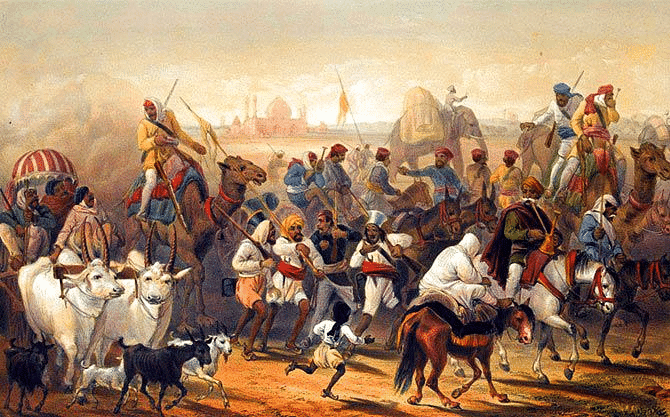
Lines of Communication
- The similarity in the pattern of the revolt in different places can be partly attributed to planning and coordination.
- There was communication between the sepoy lines of various cantonments, as evidenced by the letter sent by the 7th Awadh Irregular Cavalry to the 48th Native Infantry.
- Sepoys or their emissaries moved from one station to another, indicating that people were planning and discussing the rebellion.
- The mutinies were organized, suggesting that there were planners involved.
- Captain Hearsey's protection by his Indian subordinates during the mutiny provides clues on how the mutinies were organized.
- Panchayats, or collective decision-making bodies, were a common occurrence in the Kanpur sepoy lines.
- The sepoys took collective decisions and were the creators of their own rebellion.
Leaders and Followers
- Leadership and organization were necessary for the rebels to fight against the British.
- The rebels often turned to former leaders who had existed before British conquest.
- The sepoys of Meerut rushed to Delhi and appealed to the old Mughal emperor to lead the revolt.
- Initially, the emperor was horrified and rejected the offer, but eventually accepted when some sepoys entered the Mughal court.
- In Kanpur, Nana Sahib, the successor to Peshwa Baji Rao II, was forced to join the revolt as their leader.
- The rani of Jhansi and Kunwar Singh in Arrah were also pressured to assume leadership roles in their respective regions.
- In Awadh, the people celebrated the fall of British rule by hailing Birjis Qadr, the young son of the Nawab, as their leader.
- Rebellion leaders were not always from the court; ordinary people, religious figures, and local leaders also carried the message of rebellion.
- Reports from Meerut mentioned a fakir riding on an elephant who was visited frequently by the sepoys.
- In Lucknow, after the annexation of Awadh, there were numerous religious leaders and self-proclaimed prophets preaching against British rule.
- Local leaders like Shah Mal in Uttar Pradesh and Gonoo in Singhbhum mobilized peasants, zamindars, and tribals to revolt.
Two Rebels of 1857
Shah Mal
- Shah Mal, a resident of a large village in Uttar Pradesh, belonged to a clan of Jat cultivators.
- The region had fertile land and a well-developed irrigation system.
- Many villagers considered the British land revenue system oppressive, leading to the loss of land to outsiders such as traders and moneylenders.
- Shah Mal organized the headmen and cultivators of eighty-four villages to rebel against the British.
- The rebellion soon expanded to target all forms of oppression and injustice.
- Cultivators left their fields to plunder the houses of moneylenders and traders.
- Displaced proprietors reclaimed the lands they had lost.
- Government buildings were attacked, bridges destroyed, and metalled roads dug up to hinder the arrival of government forces and symbolically resist British rule.
- Supplies were sent to mutinous sepoys in Delhi, and all official communication between British headquarters and Meerut was cut off.
- Shah Mal assumed the role of a local Raja, taking over an English officer's bungalow and establishing a "hall of justice" to settle disputes and deliver judgments.
- He also created an effective intelligence network.
- The local population felt a sense of empowerment and believed that British rule was coming to an end.
- Shah Mal died in battle in July 1857.
Maulvi Ahmadullah Shah
- Maulvi Ahmadullah Shah played a significant role in the IS57 revolt.
- He was educated in Hyderabad and became a preacher at a young age.
- In 1856, he traveled from village to village preaching jehad against the British and encouraging rebellion.
- He was known as Danka Shah because he moved in a palanquin with drumbeaters and followers.
- Many Muslims saw him as an inspired prophet and thousands began following him.
- British officials became alarmed by his growing influence.
- In 1856, he was prevented from preaching in Lucknow by the police.
- He was later imprisoned in Faizabad but was released.
- The mutinous 22nd Native Infantry elected him as their leader.
- He fought in the Battle of Chinhat and his forces defeated the British under Henry Lawrence.
- He was believed to be invincible and possessed magical powers by some people, which added to his authority.
Rumours and Prophecies
- Rumours and prophecies played a significant role in motivating people to take action during the events leading up to the Indian Rebellion of 1857.
- One such rumour involved the sepoys in Delhi being told that the bullets given to them were coated with the fat of cows and pigs, which would corrupt their caste and religion if they bit them.
- The origin of this rumour can be traced back to a low-caste khalasi who reportedly told a Brahmin sepoy that he would soon have to bite cartridges covered with the fat of cows and pigs.
- Despite efforts by British officers to explain that this was not true, the rumour spread rapidly among the sepoys in North India, causing fear and unrest.
- Another rumour circulating at the time was that the British government had conspired to destroy the caste and religion of Hindus and Muslims by mixing bone dust of cows and pigs into the flour sold in the market.
- This led to a refusal by sepoys and common people to touch the flour, as well as a fear that the British wanted to convert Indians to Christianity.
- These fears and rumours stirred men to take action against British rule.
- The prophecy that British rule would come to an end on the centenary of the Battle of Plassey further reinforced the call for action.
- In addition to rumours, reports emerged of chapattis being distributed from village to village, with the purpose and meaning of this distribution remaining unclear.
- However, people interpreted it as an omen of an impending upheaval.
Why did people believe in the rumours?
- To understand the significance of rumours and prophecies in history, we must analyze what they reveal about the beliefs and fears of the people who believed in them.
- Rumours circulate when they resonate with the deep fears and suspicions of the people.
- The rumours in 1857 can be understood in the context of the British policies implemented from the late 1820s.
- These policies aimed to reform Indian society by introducing Western education, ideas, and institutions.
- The British established English-medium schools, colleges, and universities that taught Western sciences and liberal arts.
- They also implemented laws to abolish customs like sati and allow the remarriage of Hindu widows.
- The British annexed territories like Awadh, Jhansi, and Satara, introducing their own administration, laws, and methods of land settlement and revenue collection.
- The cumulative impact of these changes was profound, as it seemed that everything cherished by the people, from kings and socio-religious customs to landholding patterns, was being destroyed and replaced by a more impersonal, alien, and oppressive system.
- Christian missionaries also contributed to the perception of uncertainty and further fueled rumours.
- To delve into the causes of the 1857 revolt, the case of Awadh can be examined as one of the major centers where the rebellion unfolded.
Awadh in Revolt
"A cherry that will drop into our mouth one day"
- In 1851, Lord Dalhousie, the Governor General, described Awadh as a valuable territory that would eventually be under British control.
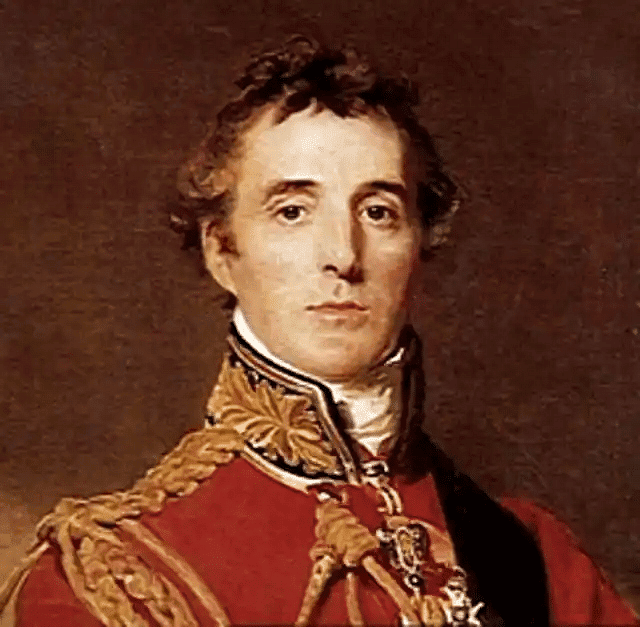
- The kingdom of Awadh was officially annexed by the British Empire in 1856, five years later.
- The conquest of Awadh happened gradually through the imposition of the Subsidiary Alliance in 1801.
- Under the Subsidiary Alliance, the Nawab of Awadh had to disband his military, allow British troops in the kingdom, and follow the advice of the British Resident.
- The Nawab became reliant on the British for maintaining law and order as he lost control over rebellious chiefs and taluqdars.
- The British were motivated to acquire Awadh due to its fertile soil for indigo and cotton production and its strategic location for trade.
- By the early 1850s, the British had already conquered major regions of India, and the takeover of Awadh was seen as completing their territorial annexation.
- The process of British territorial expansion in India had begun with the conquest of Bengal almost a century earlier.
"The life was gone out of the body"
- Lord Dalhousie's annexations caused discontent in the areas and principalities that were annexed, particularly in the kingdom of Awadh.
- Nawab Wajid Ali Shah was dethroned and exiled to Calcutta under the pretext of misgovernance, despite being a popular ruler.
- Many people in Lucknow, the capital of Awadh, expressed their grief and loss at the Nawab's exile, with some even following him to Kanpur.
- Contemporary observers recorded the widespread sense of grief and described the town as lifeless without the Nawab.
- A folk song lamented the English taking over the country.
- The material losses were significant, as the dissolution of the court and its culture affected various individuals such as musicians, dancers, poets, artisans, cooks, and administrative officials who lost their livelihoods.
Firangi Raj and the end of a World
- The annexation of Awadh by the British in 1857 resulted in the displacement and disempowerment of the taluqdars (landowners) in the region.
- The taluqdars had controlled land and power in the countryside for generations, maintaining armed retainers and enjoying a degree of autonomy under the suzerainty of the Nawab.
- The British were unwilling to tolerate the power of the taluqdars and immediately disbanded them and destroyed their forts.
- The British land revenue policy further undermined the position and authority of the taluqdars by considering them interlopers with no permanent stake in the land.
- The Summary Settlement of 1856 aimed to remove taluqdars and settle the land with the actual owners, but this led to increased exploitation of peasants without reducing their burden.
- The taluqdars lost a significant number of villages they had previously held, particularly in southern Awadh.
- The annexation and subsequent land policies left both the taluqdars and peasants dissatisfied and unhappy with the British rule.
- The dispossession of taluqdars led to the breakdown of the social order, disrupting the ties of loyalty and patronage between peasants and taluqdars.
- Under British rule, peasants were exposed to overassessment of revenue and inflexible methods of collection, with no guarantee of reduced demands or support during times of hardship or festivities.
- Many taluqdars in areas like Awadh joined the resistance against the British during the 1857 uprising, fighting alongside their peasants and remaining loyal to the Nawab of Awadh.
- The grievances of peasants were carried over to the sepoy lines, as a majority of sepoys were recruited from villages in Awadh.
- Relations between sepoys and their white officers changed in the years leading up to the uprising, with officers treating sepoys as their racial inferiors and using abuse and violence.
- The sepoys had close links with the rural world of North India, with many being recruited from villages in Awadh and eastern Uttar Pradesh.
- The changes and threats witnessed by the families of sepoys were quickly communicated to the sepoy lines, leading to fears about the new cartridge, grievances about leave, and resentment towards white officers.
- The link between sepoys and the rural world played a significant role in the uprising, as sepoys defying their officers were joined by villagers in collective acts of rebellion.
What the Rebels Wanted
- The British, as victors, recorded their own experiences during the rebellion in 1857.
- They portrayed the rebels as ungrateful and barbaric.
- The rebels had limited opportunities to record their version of events, as most of them were not literate.
- The British repression of the rebels also silenced their voices.
- The perspective of the rebels is difficult to ascertain due to the lack of written sources from their side.
- Reconstruction of the events heavily relies on British accounts, which do not provide much insight into the rebels' intentions and desires.
The Vision of Unity
- The rebel proclamations in 1857 were directed towards all sections of the population, regardless of their caste and creed.
- Many of these proclamations were issued by Muslim princes or in their names, but they made sure to address the sentiments of Hindus as well.
- The rebellion was considered a war in which both Hindus and Muslims had equal stakes.
- The proclamations emphasized the harmonious coexistence of different communities under the Mughal Empire, before the arrival of the British.
- The proclamation issued under the name of Bahadur Shah encouraged people to join the fight under the standards of both Muhammad and Mahavir.
- Despite British attempts to create religious divisions between Hindus and Muslims, such divisions were hardly noticeable during the uprising.
- In December 1857, the British tried to incite the Hindu population against Muslims in Bareilly, spending a significant sum of Rs 50,000. However, their attempt failed.
Against the Symbols of Oppression
- The proclamations issued by the rebels completely rejected British rule and condemned their actions such as annexations and broken treaties.
- The British were accused of being untrustworthy and were blamed for dispossessing landholders and ruining artisans and weavers through land revenue settlements and foreign commerce.
- The rebels wanted to restore the familiar and cherished way of life that had been destroyed by the British.
- The proclamations expressed the fear that the British were trying to destroy the caste and religions of Hindus and Muslims and convert them to Christianity.
- People were urged to come together and fight to save their livelihood, faith, honor, and identity.
- The rebellion widened in some places to attack all those seen as allies of the British or local oppressors.
- The rebels sought to humiliate the elites of cities and overturn traditional hierarchies.
- They burnt account books and ransacked moneylenders' houses in villages.
- This reflected a desire to rebel against all oppressors and envision a more egalitarian society.
- The proclamations aimed to unify all social groups in the fight against British rule.
The Search for Alternative Power
- After British rule collapsed, rebels in Delhi, Lucknow, and Kanpur attempted to establish their own authority and administration.
- Their attempts were short-lived but demonstrated their desire to return to the pre-British world of the 18th century.
- The rebel leaders looked to the culture of the court for guidance and made appointments to various positions of power.
- They also made arrangements for the collection of land revenue and payment of troops, and issued orders to stop looting and plundering.
- Alongside these administrative efforts, plans were made to fight against the British, with clear chains of command established in the rebel army.
- The rebels' administrative structures were primarily focused on meeting the demands of war, but were ultimately unable to withstand the British onslaught in most cases.
- However, in Awadh, where resistance to the British lasted the longest, the Lucknow court continued to make plans for counter-attacks and maintained hierarchical command structures until the last months of 1857 and early part of 1858.
Repression
- The British faced difficulties in suppressing the rebellion of 1857.
- They passed laws to help them quell the insurgency, including putting North India under martial law.
- Military officers and ordinary Britons were given the power to try and punish Indians suspected of rebellion.
- The ordinary processes of law and trial were suspended, and rebellion was punished with death.
- The British launched a two-pronged attack, with forces moving from Calcutta and the Punjab to reconquer Delhi.
- It took several months for the British to capture Delhi, with heavy fighting and losses on both sides.
- Rebels from all over North India had come to Delhi to defend the capital.
- The reconquest of the Gangetic plain was slow, as the British had to go village by village.
- The local population was largely hostile and offered significant support to the uprising.
- Popular support for the rebellion was estimated to be high, with three-fourths of the adult male population in Awadh participating.
- The British used military power extensively, but also used other tactics such as promising to return estates to loyal landholders.
- Rebel landholders were dispossessed and loyal landholders were rewarded.
- Many rebel landholders died fighting the British or fled to Nepal where they died from illness or starvation.
Images of the Revolt
- There is limited information on the rebels' perspective and activities during the revolt.
- Historians primarily rely on British accounts to understand rebel actions.
- Official accounts from colonial administrators and military personnel provide insight into the mindset and attitudes of the British.
- Memos, notes, assessments, and reports produced by officials shed light on their fears and perceptions of the rebels.
- British newspapers and magazines published stories that portrayed the violence of the mutineers, which fueled public anger and calls for retribution.
- Pictorial images created by both British and Indian artists, such as paintings, drawings, posters, and cartoons, offer another perspective on the mutiny.
Celebrating the Saviours
- British pictures were designed to elicit different emotions and reactions.
- Some of these images honored British heroes who saved England and suppressed rebellions.
- "Relief of Lucknow" by Thomas Jones Barker is an example of this type of painting.
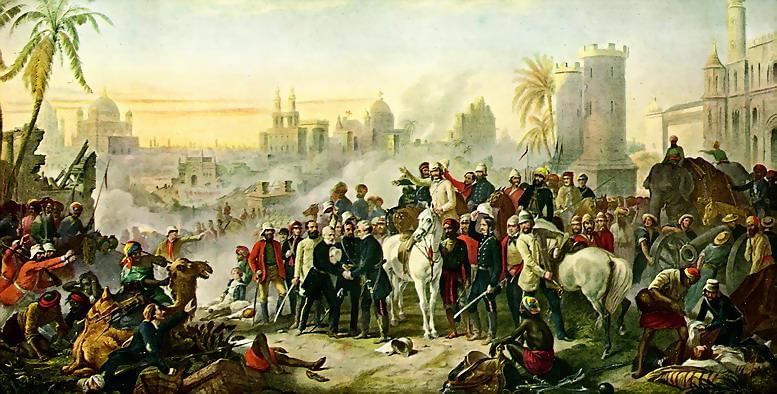
- The painting depicts the siege of Lucknow, where British Commissioner Henry Lawrence gathered the Christian population and took refuge in the fortified Residency.
- Despite Lawrence's death, the Residency continued to be defended under the command of Colonel Inglis.
- James Outram and Hemy Havelock arrived later, breaking through the rebel forces and reinforcing the British garrisons.
- Colin Campbell, the new Commander of British forces in India, arrived twenty days later and rescued the besieged British garrison.
- Barker's painting celebrates Campbell's entry and prominently features Campbell, Outram, and Havelock.
- The gestures of the surrounding figures in the painting lead the viewer's eyes towards the center.
- The painting portrays a well-lit ground, with shadows in the foreground and the damaged Residency in the background.
- The presence of the dead and injured in the foreground symbolizes the suffering during the siege.
- The triumphant figures of horses in the middle ground highlight the re-establishment of British power and control.
- These types of paintings reassured the British public by creating a sense that the rebellion was over and the British were the victors.
English Women and the Honour of Britain
- Newspaper reports have a strong influence on public perception and attitudes towards events.
- Particularly, stories of violence against women and children provoke strong emotions and demands for revenge and protection.
- Artists reflect and shape these sentiments through their visual representations of trauma and suffering.
- "In Memoriam" by Joseph Noel Paton depicts English women and children appearing helpless and innocent, waiting for dishonour, violence, and death.
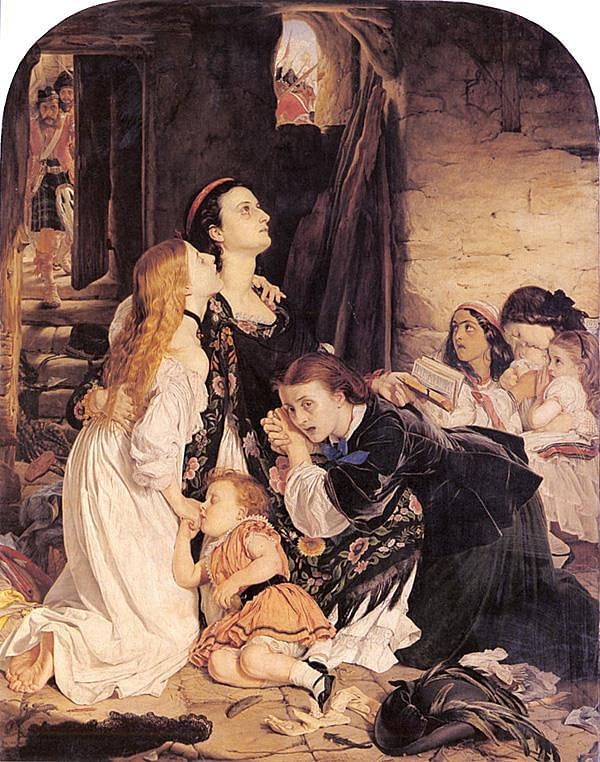
- The painting suggests violence without explicitly showing it, aiming to provoke anger and fury in the viewer.
- The rebels are portrayed as violent and brutish, although they remain invisible in the picture.
- British rescue forces are shown in the background as saviors.
- Other sketches and paintings depict women in a heroic light, defending themselves against rebel attacks.
- In one example, Miss Wheeler stands at the center, single-handedly killing attacking rebels to defend her honor.
- The rebels in these representations are demonized, shown as burly males with weapons.
- The struggle to save honor and life is given a religious connotation, seen as a battle to protect the honor of Christianity.
- The presence of a Bible on the floor emphasizes the religious significance of the woman's fight.
Vengeance and Retribution
- Anger and shock spread in Britain following the revolt
- Calls for retribution grew louder
- Visual representations and news about the revolt created an environment where violent repression and vengeance were seen as necessary and just.
- The British felt the need to demonstrate their invincibility in the face of the rebellion.
- Images and cartoons in the British press supported brutal repression and violent reprisal.
The Performance of Terror
- The desire for vengeance and retribution was evident in the brutal methods used to execute the rebels.
- The rebels were either blown from guns or hanged from gallows as a means of punishment.
- The widespread dissemination of images depicting these executions was facilitated through popular journals.
No Time for Clemency
- During a time when people were demanding revenge, calls for moderation were made fun of.
- Governor General Canning suggested that showing leniency and mercy could help regain the loyalty of the sepoys.
- However, the British press ridiculed Canning's idea, as seen in a cartoon published in Punch.
- The cartoon depicts Canning as a father figure protecting a sepoy who still holds bloody weapons.
- This imagery was commonly used in other British pictures of the time.
Nationalist Imageries
- The nationalist movement in the twentieth century was inspired by the events of 1857, which were celebrated as the First War of Independence.
- The revolt of 1857 was seen as a united fight against imperial rule, with all sections of Indian society coming together.
- Art, literature, and historical writings played a significant role in keeping the memory of 1857 alive and portraying its leaders as heroic figures.
- Rani of Jhansi, in particular, was represented as a brave and masculine figure, fighting fiercely against the British and even chasing down enemies.
- The valour and determination of Rani Lakshmi Bai were symbolized by her portrayal in battle armor, wielding a sword, and riding a horse.
- The popular saying "Khoob lari mardani woh to Jhansi wali rani thi" (Like a man she fought, she was the Rani of Jhansi) by Subhadra Kumari Chauhan highlights the bravery of Rani Lakshmi Bai.
|
30 videos|274 docs|25 tests
|
FAQs on Rebels and The Raj Class 12 History
| 1. What were the patterns of the Rebellion of 1857? |  |
| 2. Who were the two prominent rebels of 1857? |  |
| 3. How did Awadh participate in the revolt of 1857? |  |
| 4. What were the demands of the rebels during the Rebellion of 1857? |  |
| 5. How did the British repress the Rebellion of 1857? |  |





















